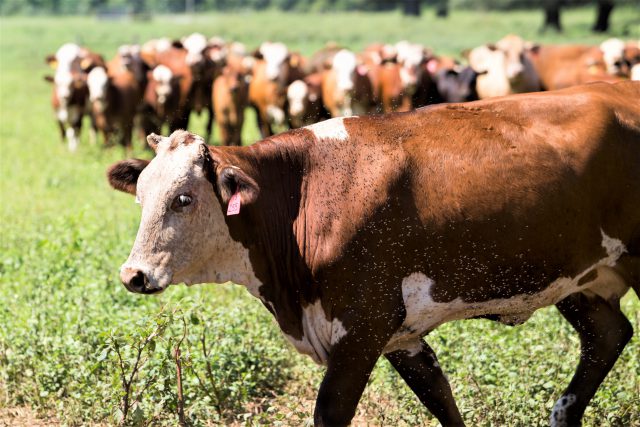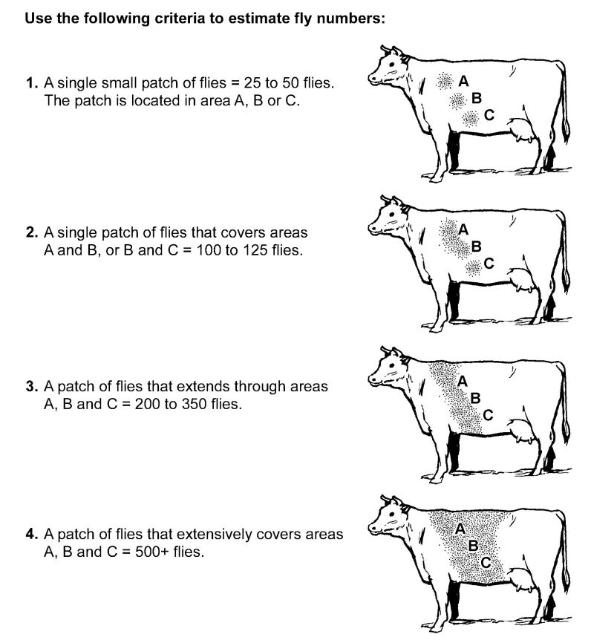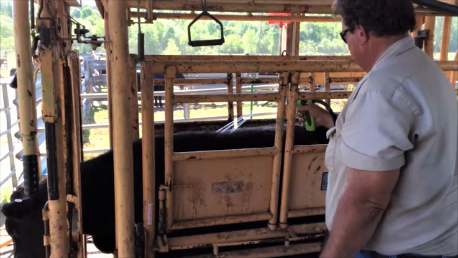The temperature has risen across the Southeastern United States, and so has the water in rain gauges in many areas. For cattle producers this brings on much needed summer forages, hay production, and time to evaluate their cattle after a mild spring. This time of year also brings on one of the most common nuisance for cattle, biting flies. Pest flies are attracted to cattle as a food source, primarily in the form of blood.

Biting flies on cattle at the North Florida Research and Education Center in Marianna, Florida. Credit: UF/IFAS Tyler Jones.
In general, there are three types of flies that affect cattle:
Face Flies
Musca autumnalis, are robust flies that resembles the common house fly. They are non-biting flies that feed on the mucus and secretions around an animal’s eye. An abundant number of flies can usually generate excess mucus secretions from the eyes compounding the problem. One primary concern with the face fly is that it can spread the bacterium Moraxella bovis that causes pinkeye in cattle.
Horn Flies
Haematobia iritans, are slightly smaller than the face fly or stable fly. These are blood-sucking pests with both sexes having piercing mouthparts they use to penetrate the cows skin to feed on blood. Horn flies will usually remain on the cow only relocating when disturbed or to lay eggs on fresh manure. Common locations for these flies to land are on the sides of the cow behind the shoulders or directly on the back, depending on length of hair.
Horse flies
Tabanus spp, are painfull, blood sucking pests that cause extreme irritation to cattle. Interestingly, only the adult female bites. They are generally daytime feeders that use piercing/chewing mouth parts to feed on the blood of the animal. Horse flies will sometimes move from animal to animal until they can locate an area where they will be least disturbed. This makes horse flies the most difficult to control of the three. Due to their intermittent feeding activity, they are prone to spread disease, most notably anaplasmosis, a blood-disease that can cause abortions and death in cattle.
Adult flies can take up 20-30 bloodmeals a day. This can result in the animal losing up to a pint of blood a day. Flies interrupt grazing and can reduce weight gain by 17-33% over an 80-day period. This is especially true for growing calves with more than 200 flies, reducing weaning weights by up to 15 pounds. Flies in these large populations can lead to a devastating loss of profit. Up to $68/head can be lost due to overpopulation of flies, and a total industry loss of $1 billion for the entire United States. No producer wants to lose money, especially when there is a solution to the problem.
Research has shown that the economic threshold for treatment of flies is 100 flies per side (200 total) for a cow, and 50 flies per side for a calf. Once this threshold is reached, biting flies will have negative impacts on cattle performance, so some sort of fly control program is important.

A method of estimating horn fly numbers in the field. Source: Horn Fly Management
Knowing how and where flies prefer to reproduce can be helpful to prevent fly populations from growing. Horn flies, for example, lay their eggs in fresh manure, and the larvae hatch within one week. The larvae will then develop in the manure and then pupate into the drier ground underneath. They complete their development from egg to adult stage between 10 and 20 days depending upon weather. Adult flies can live up to three weeks with normal feeding.

Horn flies can be controlled using a variety of methods including insecticide sprays, back rubbing devices, dust bags, insecticide-impregnated ear tags, and feed-through insecticides. Credit: UF/IFAS Nick Simmons.
Face flies and horn flies can be controlled using a variety of methods including insecticide sprays, back rubbing devices, dust bags, insecticide-impregnated ear tags, and feed-through insecticides. Insecticide ear tags have been used with success for many years. They are most effective when using two tags per animal and applied early in the season, and removed at the end of summer to prevent resistance from weak insecticide. There are two main types of active ingredients that should be rotated each year to prevent resistance as well. Oil-based applicators, pour-on, and direct sprays are also effective methods, but are more labor and cost intensive. In the end, the producer must decide what is best for their herd. Considerations should be made for facilities and pressure load from pests.
For more information on this topic, contact your local Extension Office, or use the following publication links:
External Parasites on Beef Cattle
Horn Fly Haematobia irritans irritans
Cattle Fly Control Tips
Horn Fly Control for Beef Cattle
- 2026 Santa Rosa CountyRow Crop Production Meeting – January 22 - December 19, 2025
- Hay Quality and Quantity Considerations for Winter Feeding - September 5, 2025
- Managing Lice on Cattle - February 28, 2025
